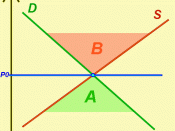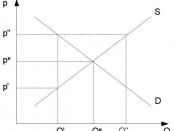The Laws of Supply and Demand - 4
The ''law of demand'' states that, all other variables remaining the same, the higher the price, the less the quantity demanded.
This can be seen in the diagram to your left. Fred the butcher notices that when the price of beef is $6 per kilogram, 150 kilograms are bought each week. When the price of beef is $8 per kilogram, 100 kilograms are bought each week.
The ''law of supply'' states that the higher the price of a good or service, all other variables remaining the same, the greater the quantity is supplied.
In the diagram, we can see this effect. When the price of beef is $6 per kilogram, Fred the butcher will supply 50 kilograms per week. When the price of beef rises to $8 per kilogram, Fred will supply 100 kilograms per week.
The Laws of Supply and Demand - 5
In a market economy, the prices of goods and services are influenced by the interaction of the market forces of supply and demand.
If there are only a limited stock of some product available, competition between potential buyers tends to see prices rise, a consumers ''bid up'' prices.
Can you see this effect in the diagram to your right?
Similarly, competition between sellers of the product tends to see prices fall, as they try to attract buyers.
Markets generally reach an equilibrium price and quantity, where suppliers and consumers reach a compromise. Setting prices too high can lead to low sales, and the potential for making a loss. Demanding low prices may lead to no purcha



Good basics
Very skeleteon however. You need to talk about WHY markets reach an equilibrium price and quantity, and what happens in a situation where there is excess supply or excess demand.
0 out of 0 people found this comment useful.